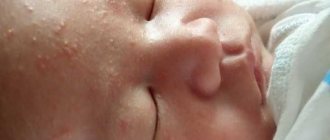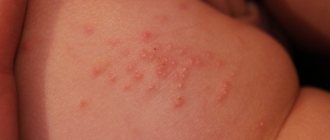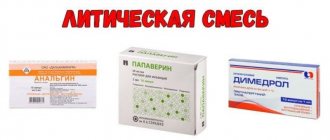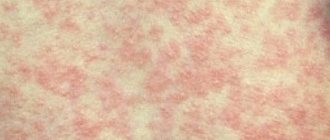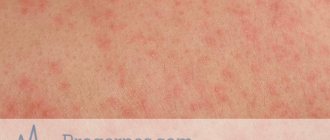If you suspect a child has a sore throat, it is imperative to consult a doctor, because specialists have more opportunities to diagnose and prescribe adequate therapy. Parents need to remember that follicular tonsillitis in a child occurs in the event of a bacterial or viral infection. However, redness and plaque in the oropharynx are also characteristic of mononucleosis, stomatitis and diphtheria. Diseases of different etiologies require different approaches to treatment.
Follicular tonsillitis is one of the types of acute tonsillitis
In public clinics, the appointment resembles a factory assembly line: the standard time per patient is 12 minutes, as a result, the doctor sees 5 patients per hour. Doctors rarely manage to delve deeply into the problems of each visitor; there is simply not enough time to discuss many issues.
Pediatricians give detailed recommendations to mothers of children under one year old; as the baby grows up, they dwell less and less on the intricacies of child care. It is not surprising that parents are left with a swarm of questions in their heads about modern drugs and analogues, and possible complications of the disease.
The most common types of sore throat:
Catarrhal
A less severe version of the disease with simple treatment. The child feels pain and burning in the throat, it hurts him to swallow. The mucous membrane of the oropharynx is hyperemic, with a whitish coating.
Follicular
Purulent follicles appear on the palatine tonsils; they stand out against the background of swollen and reddened lymphoid tissue. Symptoms of general intoxication occur.
Most often, follicular tonsillitis develops after infection with streptococci and is accompanied by lymphadenitis.
Lacunarnaya
The appearance of yellow plaque in the lacunae of the palatine tonsils is characteristic. Severe sore throat, nasal voice.
If a child complains of a sore throat and neck, his temperature has risen, or his appetite has worsened, then it is necessary to call a local pediatrician at home. For less severe cases, you should make an appointment with a doctor and take a swab from the oropharynx. You may need to consult an ENT doctor.
Provoking factors, types
Most often the disease causes:
Some other factors also play a major role in development, for example, the psycho-emotional state and the characteristics of the immune system. It is very important to determine the specifics of the body’s functioning, since approaches to treatment caused by microbes differ significantly. With viral sore throat, the main emphasis is on increasing immunity.
Sometimes the Coxsackie virus leads to the formation of the disease. When the agent gets on the mucous membrane, characteristic rashes appear that resemble herpes. This variety is called vesicular.
Dr. Komarovsky talks about the dangerous manifestations of tonsillitis:
Development of follicular sore throat
The infection enters the throat through airborne droplets, as well as through the use of shared utensils, towels, and other household contacts. During the cold season, the load on the lymphatic system increases. The risk of infection by viruses and bacteria increases. If a doctor diagnoses follicular tonsillitis in a 3-year-old child, then most likely the infection occurred due to contact with sick children in kindergarten or in the yard.
Symptoms of follicular tonsillitis:
- redness of the tonsils and palatine arches;
- feeling of dryness of the oral mucosa;
- temperature above 38°C lasts for several days;
- chills, general weakness, joint pain, headache;
- sore throat, gradually increasing pain radiates to the ear;
- enlarged lymph nodes, their pain on palpation;
- loss of appetite, vomiting, diarrhea.
Lymphoid follicles are responsible for the production of lymphocytes, macrophages and other local immunity factors. The formations are included in the structure of the tonsils and are scattered along the back wall of the pharynx. The average size of a follicle is about the size of a millet grain. They are filled with pus not immediately, but gradually. Pharyngoscopy at an appointment with an ENT doctor can reveal white-yellow or grayish formations in the tonsil area and changes in the pharyngeal ring.
Prevention and prognosis
The prognosis with proper treatment is good. In order for recovery to proceed at an accelerated pace, you need to refrain from physical activity and vaccinations for a month. Sometimes doctors suggest removing the tonsils to reduce the risk of recurrence of the disease.
But you should not immediately agree to the operation, since it is indicated only if the size of the tonsils makes it difficult to perform the normal respiratory function, and the immune system stops working fully against the background of a constantly inflamed lesion.
Preventive measures include:
- Strengthening the body's protective properties.
- Prohibition of drinking drinks that are too cold.
- Carrying out wet cleaning every day.
- Frequent ventilation of the room.
- Creating a suitable microclimate.
Prevention not only reduces the risk of developing viral tonsillitis, but also reduces the likelihood of other inflammatory diseases.
You can get a sore throat at any age. This disease is most severe in children. Quite often, sore throat occurs against the background of a viral infection.
Causes
Viruses are the second most common culprits in the development of sore throats in childhood after bacteria. Most often, the development of acute tonsillitis is caused by infection with adenovirus infection, influenza and parainfluenza, as well as herpes.
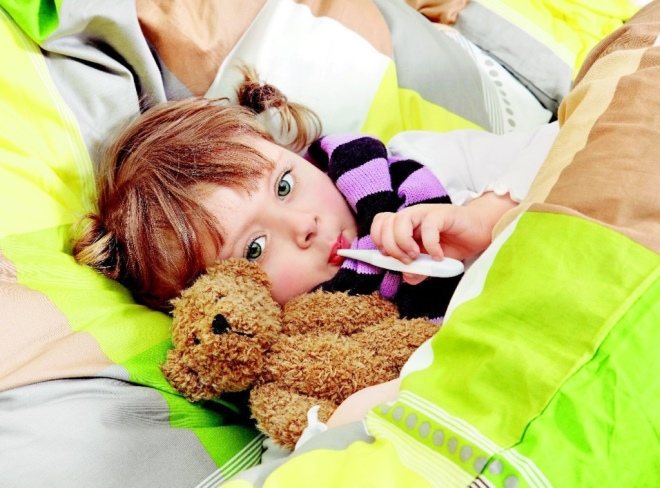
The peak incidence of such forms of sore throat occurs between the ages of 3-7 years.
Children attending educational institutions are most susceptible to infection. In crowded, organized groups, viral infections usually spread at a faster rate.
Viral tonsillitis is characterized by systemic manifestations. Catarrhal symptoms also appear: runny nose and cough. For bacterial tonsillitis, such manifestations, as a rule, are not typical and practically do not occur.
Viral forms of the disease usually progress within 5-7 days and end with complete recovery.
How can you get infected?
You can get a sore throat after any contact with a sick and contagious person. The most common type of infection is airborne.
Tiny viral particles are released into the environment when speaking or sneezing. They can stay there for quite a long time and not lose their viability. Subsequently getting on the mucous membranes of another child, the viruses begin to multiply quickly and provoke the development of an inflammatory process.
Another, also quite common method of infection is the contact-household variant.
It is possible during joint games with the same toys or when using common utensils. Similar cases of infection are observed within the family or in kindergarten. Violation of personal hygiene rules also leads to possible infection.
Symptoms
The first clinical manifestations of the disease appear after the incubation period. For viral sore throats, it usually lasts about 1-3 days.
For some forms of infection, the incubation period can even last up to a week. At this time, as a rule, the child does not have any adverse symptoms of the disease, and nothing bothers him.
The main manifestations of viral sore throat in childhood are:
- Increased body temperature. Usually it rises to 38-39 degrees during the first day of illness and persists for a couple of days. Against the background of high body temperature, fever and intense heat appear, as well as increased sweating.
- Sore throat when swallowing. Any food, especially with solid particles, can cause increased pain.
- Redness of the throat and enlarged tonsils. They turn bright red. Various rashes appear on the tonsils, as well as whitish or gray plaques. Viral sore throats are not characterized by purulent crusts. This symptom occurs only when infected with a bacterial infection.
- Enlarged peripheral lymph nodes. The occipital and submandibular areas are most often affected. They become quite dense and painful when touched.
- Severe headache, loss of appetite, change in the general condition of the child. The baby becomes more capricious, refuses to eat, and tries to spend more time in the crib. At high temperatures, symptoms of thirst and dry mouth increase.
What does it look like?
With a viral sore throat, the tonsils become enlarged and bright red. The entire pharynx and oropharynx are also scarlet. Various rashes appear on the tonsils.
With adenoviral variants of the disease, they look like white millet grains, which are located at some distance from each other.
Usually on the 4-5th day of illness they open and the fluid flows out.
In place of the former blisters, areas with erosions and ulcers remain. The surface of the tonsils becomes loose and bleeds easily when touched.
A week after the onset of herpes sore throat, the tonsils become clean and have no traces of blisters and ulcers.
Diagnostics
After the first signs of illness appear, you should definitely show your baby to the pediatrician. The doctor will examine the child's throat and be able to make the correct diagnosis.
To clarify the pathogen, additional tests and examinations are sometimes required.
For all children with tonsillitis, a smear is taken from the surface of the tonsils. It allows you to accurately identify the causative agent of the disease, as well as exclude such dangerous childhood infections as scarlet fever and diphtheria.
A general blood test is performed for all children with acute tonsillitis.
An increase in the number of lymphocytes against the general background of a high content of leukocytes indicates the presence of a viral infection in the body. Also, similar variants of acute tonsillitis occur with a strong acceleration of ESR.
Treatment
You can treat a sore throat at home. Such treatment should be carried out under the mandatory supervision of the attending physician. The doctor will be able to detect the development of complications in a timely manner, and will also make the necessary adjustments to therapy if necessary.
For the treatment of viral sore throat use:
- Antiviral agents. They help effectively cope with viruses and also promote rapid recovery. The most commonly used drugs are: Acyclovir, Remantadine, Viferon, Groprinosin, Isoprinosine. They have a pronounced viral toxic effect. Antiviral drugs are usually prescribed in the form of tablets, and in severe situations - in injections and injections.
- Immunostimulating drugs. Significantly enhance the effect of antiviral agents. They can be prescribed in the form of drops, tablets, and suppositories. In pediatric practice, the most frequently used are: Interferon, Immunal and others. They are prescribed for 7-10 days. Strengthen the immune system and promote good functioning of the immune system.
- Antipyretic. Use only when body temperature rises above 38 degrees. To improve your well-being, medications based on paracetamol or ibuprofen are ideal. Such products are approved for use in pediatric practice.
- Antihistamines. Used to eliminate swelling of the tonsils and reduce symptoms of intoxication. Prescribed for 5 days, usually 1-2 times a day. Some drugs can cause increased drowsiness, so they are usually recommended for use in the first half of the day. Suitable antihistamines include: Claritin, Suprastin, Loratadine and others.
- Warm, plenty of drink. Helps eliminate viral toxins from the body. This simple measure helps prevent the development of dangerous complications that manifest themselves as inflammation in the kidneys or heart. Suitable drinks include compotes or fruit drinks made from berries and fruits.
- Bed rest for the entire period of high temperature. Staying in bed will contribute to a quick recovery and improved well-being in a short time. Usually, with viral tonsillitis, doctors recommend that children remain in bed for 2-3 days.
- Gentle nutrition. All prepared dishes must be at a comfortable temperature, no higher than 50 degrees. Extremely cold foods can cause increased pain when swallowing. It is better to choose dishes with a thinner consistency that are not capable of injuring the tonsils.
- Rinse. They help wash the tonsils and remove plaque from their surfaces. They are usually carried out 3-4 times a day for 5-7 days. Decoctions of chamomile, calendula or sage, as well as a solution of diluted hydrogen peroxide and soda, are well suited for rinsing.
- Pain-relieving lozenges or lozenges. Eliminate pain in the throat and help reduce inflammation of the tonsils. Faringosept, Strepsils, Septolete help cope with pain when swallowing. Prescribed 3 times a day for a week. Longer use of pain-relieving lozenges is discussed with your doctor.
- Multivitamin complexes including selenium. The microelements contained in such preparations are needed for rapid recovery from illness, as well as to improve the functioning of the immune system. Selenium helps the body cope with viruses faster and activates the immune system.
- Creating a comfortable indoor microclimate. Excessively dry air in a child's room leads to difficulty breathing during a viral infection. The use of special humidifier devices helps to cope with this problem. They create optimal humidity in the children's room, which is necessary for good breathing.
Below you can watch Dr. Komarovsky’s video about sore throat in children.
Sore throat is a fairly common disease in children of all ages. Thus, before reaching 5 years of age, most children manage to experience this disease at least once. In older children, sore throat is diagnosed even more often. And if a child suffers from a chronic form of tonsillitis, then exacerbations occur more than 3 times a year . Treating a sore throat in a 2-year-old child is sometimes problematic. At this age, the baby does not know how to gargle, and it is not advisable to use antiseptic sprays. How can you help the baby?
Treatment of follicular tonsillitis in children with antibiotics
Antibacterial drugs should be prescribed to the child by a pediatrician. The doctor selects antimicrobial agents based on the clinical picture of the disease, the results of a laboratory test of a throat smear and a general blood test. Symptoms and treatment of follicular tonsillitis in children depend on the infectious agent. New generation antibiotics reduce symptoms and shorten the duration of the acute period only in the case of bacterial tonsillitis. Antibacterial drugs will not help with viral infections.
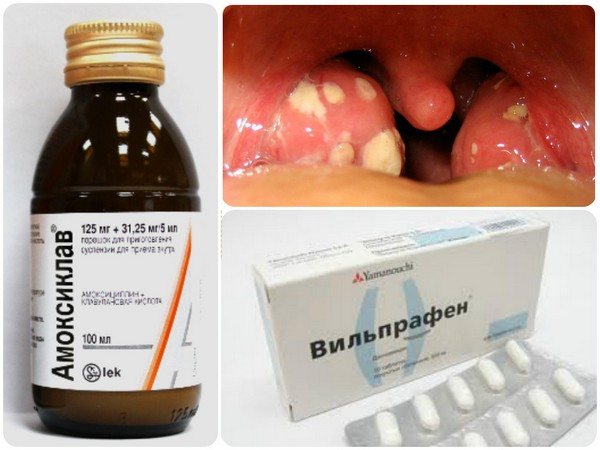
Treatment of acute tonsillitis in children and adults is carried out using substances belonging to three classes of antibiotics: penicillins, cephalosporins and macrolides. At the same time, the pediatrician recommends performing gargles, foot baths and other procedures at home to alleviate the condition of the little patient.
Penicillins have good bioavailability when taken orally. They suppress the development of streptococci, but they themselves need protection from bacterial beta-lactamases. Therefore, it must be taken in combination with clavulanic acid. Trade names of the drugs: “Amoxiclav”, “Augmentin”, “Amoxicillin”, “Flemoxin Solutab”. They are low-toxic and have less effect on the intestinal microflora than other groups of antibiotics.
Cephalosporins are also effective for acute tonsillitis. Trade names of drugs in this group: “Cefuroxime”, “Cefotaxime”. Macrolides are used to treat various types of sore throat in children. Effective and low-toxic drugs are Azithromycin and Sumamed.
It is convenient to use antibiotics in the form of a powder to treat children, which is diluted with water and given to the children to drink.
The drug "Sumamed" is popular due to its wide spectrum of antimicrobial action and short course of administration. Children over 6 months of age are given a suspension prepared from powder and water. The drug is prepared at the rate of 10 mg of the drug per 1 kg of body weight. Take the antibiotic, observing the frequency and order of administration indicated by the doctor. Manufacturers in the instructions for the drug recommend drinking the medicine once a day for 3 days.
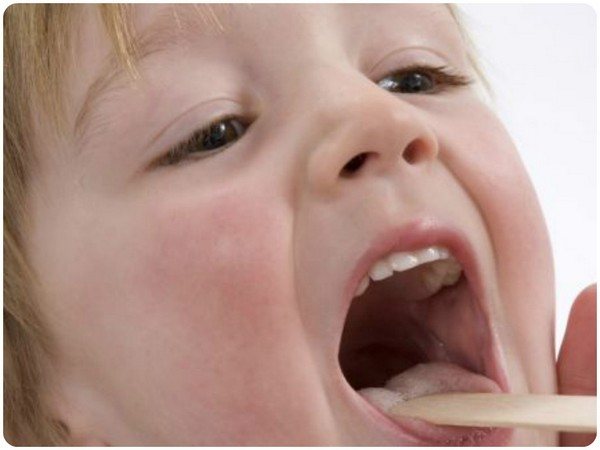
It is better to entrust the solution to the problem of treating follicular tonsillitis in children not to one, but to several specialists. You can make an appointment not only with a pediatrician, but also with an ENT doctor, as well as the head of the pediatric department. Parents who heed this advice will notice the influence of the “human factor” on approaches to treating the same child.
Experts have different assessments of the importance of concomitant therapy: inhalations, gargling, compresses.
Antibiotic therapy should be carried out according to the schedule and doses determined by the doctor. Medical specialists constantly remind that improvement of the condition is not a reason to discontinue the antibiotic. The fact is that in order to suppress the infection, the concentration of the drug in the blood must reach certain values and be maintained for some time.
Antibiotics
If a child’s angina at 3 years of age is very severe, the doctor prescribes antibacterial drugs. Both tablets and intramuscular injections can be prescribed. Quite often, doctors prescribe drugs from the penicillin group, which include Augmentin and Amoxicillin.
If there is intolerance to drugs from the penicillin group, macrolides are prescribed - Macropen, Sumamed or Azithromycin. If oral administration of antibiotics is difficult, injections of antibiotics from a number of cephalosporins are prescribed.
In case of uncomplicated sore throat in children over 2 years of age, the local antibiotic Bioparox can be prescribed. This drug can complement treatment when taking systemic antibacterial drugs.
Before using any antibiotics, perform an allergy test. The drug solution is applied to the inner bend of the elbow and wait 15 minutes. If there is no redness, then the medicine is tolerated normally.
Traditional medicine recipes for a sore throat
Drinking plenty of water improves the child’s condition and maintains the water-alkaline balance in his body. It is recommended to prepare linden tea with raspberry jam or honey, chamomile infusion, and rosehip decoction for sick children. Raspberries and blackberries, which are no less valuable for treating throat problems, can be frozen or dried, and during illness, brewed and drunk as tea. This way, phytochemical compounds that are not resistant to heat are destroyed less.
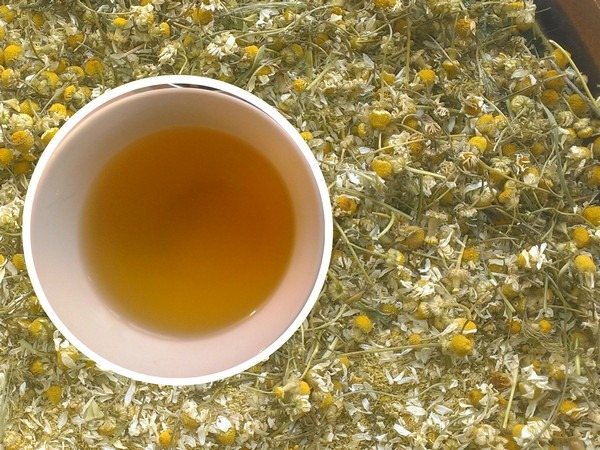
A healer's recipe for treating a sore throat with lemon (chewing a slice of lemon) has been passed down from generation to generation. Small children may cough and choke on bits, so they are given tea with lemon. Syrup made from chopped green pine cones infused in sugar is good for colds and sore throats. You can replace it with pine decoction, but when heated, vitamin C is destroyed.
Rinsing with a solution of kitchen salt or baking soda “pulls out” pus from the follicles of the tonsils. A decoction of oak bark, eucalyptus leaves, and aloe juice diluted with water helps remove pus. An infusion of thyme and St. John's wort for gargling has a bactericidal effect. During the treatment of follicular tonsillitis in children, you should not give solid food or dishes with an irritating taste and smell.
Treatment
Many parents, trying to quickly cure a viral sore throat, independently prescribe antibiotics to their child. Such drugs are ineffective. Be sure to stay in bed for the first 3-4 days of illness. You should not be around other people, as there is a high chance of becoming infected.
During treatment, it is recommended to adhere to a diet with predominantly semi-liquid and liquid foods. In order not to cause even more irritation in the throat, you should avoid pickled, salty, and spicy foods.
Features of the treatment of sore throat in children:
Medication
When the temperature rises to high levels, antipyretic drugs are used. The fastest way to achieve the desired effect is with candles and potions. Children should not be given aspirin. Give preference to ibuprofen and paracetamol. They are used to make Nurofen, Ibufen, and Ibuklin.
Additionally, immunostimulants are prescribed, which enhance the activity of the immune system and increase the likelihood of a quick recovery. Before use, do not forget to familiarize yourself with the contraindications.
For topical use, rinsing with soda, furatsilin, and chamomile is suitable. You can use Tantum Verde, Ingalipt and Miramistin sprays. When choosing the right one, the presence of contraindications and restrictions must be taken into account.
Folk remedies
To treat viral tonsillitis, a medicinal mixture is used, consisting of one part of linden and the same amount of chamomile. 10 gr. collection is poured with boiling water and left for 25 minutes. Then you need to gargle with a warm solution as often as possible.
For rinsing you can use calendula, sage, eucalyptus. A proven folk method is warm milk with the addition of honey and butter. This solution softens the mucous membrane, which reduces pain.
How to treat a sore throat with folk remedies, watch our video:
Physiotherapy
It includes a whole range of different activities:
- Treatment of tonsils using anti-inflammatory drugs.
- Tonsil cleansing.
- Using various methods of influence to accelerate tissue healing.
A popular method is UHF. During the procedure, swelling around the tonsils and lymph nodes is removed. But warming procedures cannot be used on the very place where the inflammatory focus is located.
Reducing the temperature
It is not always easy to bring down the temperature during sore throat in children. If a child has a high temperature, taking an antipyretic drug is appropriate only when the mark on the thermometer has already exceeded 38 degrees Celsius. The thing is that the active production of antibodies against pathogens occurs precisely during fever, as the body itself tries to fight them.
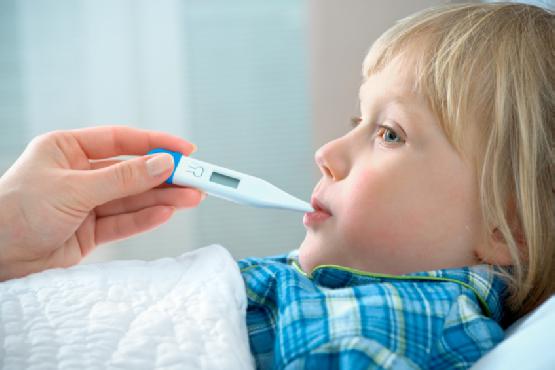
If the child feels normal even at a temperature of 39, pediatricians recommend holding off and not knocking it down. If high body temperature is not eliminated with the help of medications, folk “grandmother’s” methods, for example, wiping with a damp towel, can be used. Sweating and lowering the temperature are promoted by drinking plenty of currant, raspberry or cherry compotes.
Is hospitalization necessary?
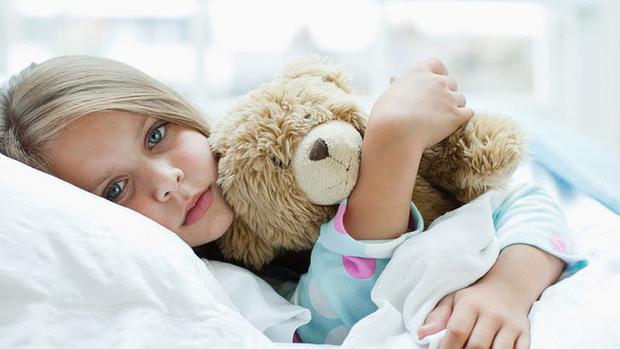
In most cases, sore throat in a 2-year-old child can be treated at home, but there are cases when hospitalization cannot be avoided. What are these cases?
- The presence of concomitant serious diseases - diabetes, renal failure and others.
- Complications of tonsillitis (for example, abscesses).
- Severe intoxication - breathing problems, vomiting, convulsions, confusion, fever that cannot be brought down.
Despite the fact that treatment in a hospital is more effective, many doctors advise treatment at home to avoid any additional infection.
How is the treatment carried out?
As the famous pediatrician Evgeniy Komarovsky says: “Sore throat in children is a disease that begins suddenly and is quite acute.” In his opinion, the only way out is a timely and clear course of treatment.
To prevent the disease from prolonging, it is necessary to strictly follow the recommendations of the treating pediatrician. A child with a sore throat most often needs fluids, antibiotics, antipyretics, and antihistamines (anti-allergic) drugs. It is also necessary to gargle and take vitamins.
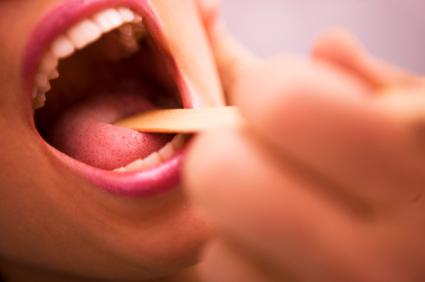
It is important to remember that a sore throat can only be treated with gargling and local medications. Under no circumstances should compresses, inhalations or warming ointments be used on the neck!
A very important aspect of treating a sore throat is gargling. However, it is very difficult for two-year-old children to explain exactly how this procedure should be carried out. Therefore, special sprays and aerosols are often used. Antibacterial agents are prescribed, as well as decoctions of sage, calendula, and chamomile. These herbs have proven to be very effective in treating the throat, especially with purulent sore throat.
It should be noted that a small child may hold his breath when injecting the spray, which can provoke lagingospasm. Infants, as a rule, treat a pacifier with medicine or direct the stream towards the cheek. Oral disintegrating tablets are also not very suitable for children under 2 years of age, as they either chew them or spit them out. In this case, it is better to treat a sore throat with alternative remedies.
Many drugs can cause an allergic reaction, so taking them is accompanied by taking antihistamine drops.
Possible complications
If treatment for a sore throat turns out to be inadequate or delayed, and the child’s immunity cannot cope with the disease, the disease can cause the development of rheumatism, glomerulonephritis, rheumatic carditis and other ailments. To exclude this possibility, you should choose only competent doctors who will monitor the course of the disease very carefully and competently. After recovery, you need to undergo all general tests, refuse vaccinations, adjust your diet, and breathe more fresh air. If, after an illness, a child complains of swelling, shortness of breath, pain in the chest or joints, you should immediately consult a doctor! Note that tonsillitis can also be chronic. In this case, you need to contact an otolaryngologist, who will talk about preventing exacerbations of the disease in more detail, depending on the specific case.
Treatment
Many parents, trying to quickly cure a viral sore throat, independently prescribe antibiotics to their child. Such drugs are ineffective. Be sure to stay in bed for the first 3-4 days of illness. You should not be around other people, as there is a high chance of becoming infected.
During treatment, it is recommended to adhere to a diet with predominantly semi-liquid and liquid foods. In order not to cause even more irritation in the throat, you should avoid pickled, salty, and spicy foods.
Features of the treatment of sore throat in children:
Medication
When the temperature rises to high levels, antipyretic drugs are used. The fastest way to achieve the desired effect is with candles and potions. Children should not be given aspirin. Give preference to ibuprofen and paracetamol. They are used to make Nurofen, Ibufen, and Ibuklin.
Additionally, immunostimulants are prescribed, which enhance the activity of the immune system and increase the likelihood of a quick recovery. Before use, do not forget to familiarize yourself with the contraindications.
For topical use, rinsing with soda, furatsilin, and chamomile is suitable. You can use Tantum Verde, Ingalipt and Miramistin sprays. When choosing the right one, the presence of contraindications and restrictions must be taken into account.
Folk remedies
To treat viral tonsillitis, a medicinal mixture is used, consisting of one part of linden and the same amount of chamomile. 10 gr. collection is poured with boiling water and left for 25 minutes. Then you need to gargle with a warm solution as often as possible.
For rinsing you can use calendula, sage, eucalyptus. A proven folk method is warm milk with the addition of honey and butter. This solution softens the mucous membrane, which reduces pain.
How to treat a sore throat with folk remedies, watch our video:
Physiotherapy
It includes a whole range of different activities:
- Treatment of tonsils using anti-inflammatory drugs.
- Tonsil cleansing.
- Using various methods of influence to accelerate tissue healing.
A popular method is UHF. During the procedure, swelling around the tonsils and lymph nodes is removed. But warming procedures cannot be used on the very place where the inflammatory focus is located.
Ultrasound helps relieve inflammation and has an analgesic effect. Ultraviolet irradiation is used as monotherapy. It leads to the death of pathogenic microflora.
Another popular method is laser therapy, which can eliminate swelling and carry out sanitation. Treatment is possible at any age.
Causes of tonsillitis in children
Throughout life, a person constantly comes into contact with many microorganisms - fungi, viruses, bacteria.
But in most cases, such meetings pass unnoticed, without affecting the well-being of either the adult or the child. This means that insemination took place in a small amount (which is the norm if body hygiene is observed) and the body’s defenses are working normally. But in some situations, infection (the introduction of microorganisms and their reproduction) is inevitable. This occurs with a temporary decrease in immune strength:
- With local hypothermia (cold drinks, ice cream);
- With general hypothermia;
- In case of a long-term psycho-traumatic situation;
- After a recent illness;
- Against the backdrop of an unfavorable environment;
- In contact with a person with purulent tonsillitis (bacterial form) or when sharing household and personal items with him (dishes, toothbrush, etc.).
In these cases, bacteria or viruses attack the body, primarily the mucous membranes, which leads to the development of inflammatory processes, in particular to diseases such as tonsillitis, pharyngitis, rhinitis. Serious medical attention is often required to eliminate these diseases. Viruses in most cases cause a simple (catarrhal) form of tonsillitis, while bacteria (mainly staphylococcus) cause purulent tonsillitis (follicular and lacunar form of tonsillitis in children).
The incubation period for bacterial tonsillitis is two to five days after exposure. However, if the patient with whom contact occurred took antibiotics, then he was not infectious. 24 hours after starting antibiotics, the patient becomes non-infectious.
Treatment of the disease
To know how to treat a sore throat in a 1-year-old child, the doctor must identify the type of disease. To do this, the pediatrician interviews the parents and checks the child’s condition. Inspects the oral cavity with a special laryngeal mirror. To exclude diphtheria infection, a swab is taken from the nasal passages and pharynx using a Lefler stick.
A smear is necessarily taken from the patient for bacteriological examination. This is necessary to identify the pathogen. Based on the results obtained from the procedures and examinations performed, the doctor prescribes effective antibiotics and other drugs to which viral infections are most sensitive. To identify internal indicators, material is taken for analysis of urine and general lymph.
It is strictly forbidden to subject a child to therapeutic effects on your own. This threatens the emergence of serious complications and the progression of sore throat into a chronic condition. Children under 3 years of age, on the recommendation of pediatricians, are not treated at home. Children with kidney disease, congenital diabetes mellitus, and problems with blood clotting should also be observed in the hospital.
If the pediatrician sees no reason for hospitalization, then therapy at home is allowed, but under the supervision of a supervising doctor. In such a situation, the patient needs to be isolated from healthy family members and given separate hygiene items and utensils.
During the period of fever, you will need to constantly adhere to bed rest. To reduce the impact of intoxication on internal organs, you need to increase the volume of drinking. It is recommended to give your baby decoctions of dried fruits, raisins, and boiled water. If the baby is breastfed, do not wean at this moment.
If there is no body temperature, then there is the opportunity to walk with the child in the fresh air. Be sure to ventilate the rooms and do wet cleaning where the patient is most present. Do not exclude bathing and washing the child, only if there is no fever.
Drug therapy
Therapeutic intervention when detecting acute sore throat in a small child should be carried out comprehensively. To do this, the doctor prescribes medications depending on the age category and the state of the pathology. There is a regimen presented in the table, which is usually used to treat a serious illness.
| Treatments | Actions | Medicines |
| Antipyretics | Temperature reduction is carried out only after 38.1-38.5 degrees. A lower indicator should be reduced if the child has previously had seizures | Paracetamol, Panadol |
| Antibacterial | These drugs are divided into groups, so their prescription is regulated exclusively by the pediatrician, depending on the baby’s weight and the severity of the sore throat. Course duration is 10 days. | All medications are prescribed only on an individual basis |
| Antiviral | Necessary for viral tonsillitis to reduce the significant impact of pathogenic bacteria and viral infections on the body. Prescribed once a day | Kipferon, Viferon |
| Probiotics | Necessary for normalizing flora in the stomach and intestines after antibiotics are administered | Bafidumbacterin, Linex, Biobakton |
| Antihistamines | Block the possibility of developing allergies, neutralize swelling of the sinuses and tonsils | Suprastin, Zodak, Fenistil, Cetrin, |
| Vitamins | Taken to strengthen the immune system and increase the body's protective function | Alphabet |
| Local remedies | Injecting funds is strictly prohibited. Use these medications as an application to the pacifier | Miramistin, Furacilin, Chlorophyllipt, |
For older children, rinsing with antiseptics and folk herbs is actively used. Such processing is prohibited for children. Also, you should not use medications such as Lugol or Iodinol. These substances negatively affect the mucous membrane of the baby, burning it.
It is prohibited to apply medications to gauze and treat the oral cavity and tonsils. In this situation, it is possible not to remove plaque, but to sow it on healthy areas of the mouth.
Any therapeutic actions should be carried out only after eating 30 minutes. This period of time will allow the drugs to fully produce the positive effects of exposure.
All medications can be purchased on the website or at a hospital pharmacy.
Provoking factors, types
Most often the disease causes:
Some other factors also play a major role in development, for example, the psycho-emotional state and the characteristics of the immune system. It is very important to determine the specifics of the body’s functioning, since approaches to treatment caused by microbes differ significantly. With viral sore throat, the main emphasis is on increasing immunity.
Sometimes the Coxsackie virus leads to the formation of the disease. When the agent gets on the mucous membrane, characteristic rashes appear that resemble herpes. This variety is called vesicular.
